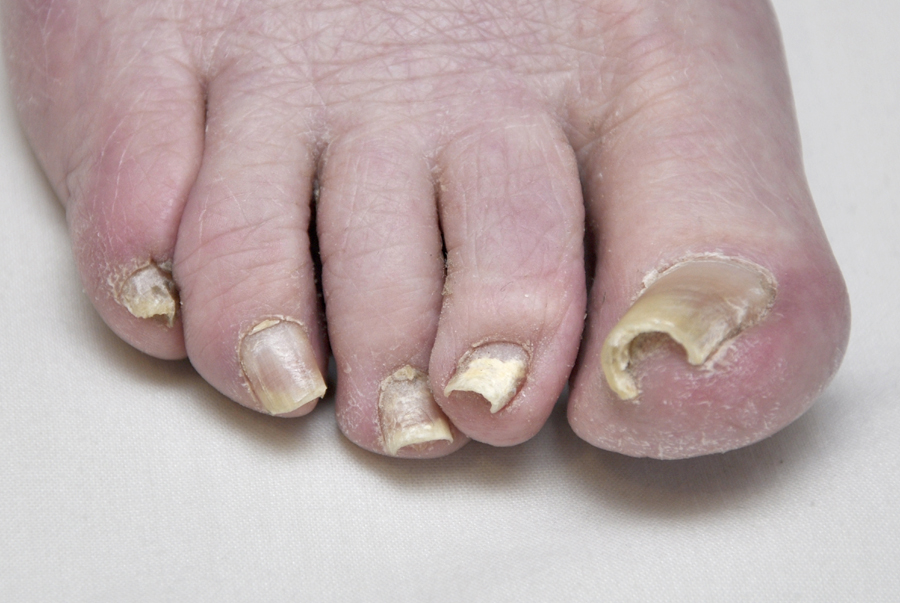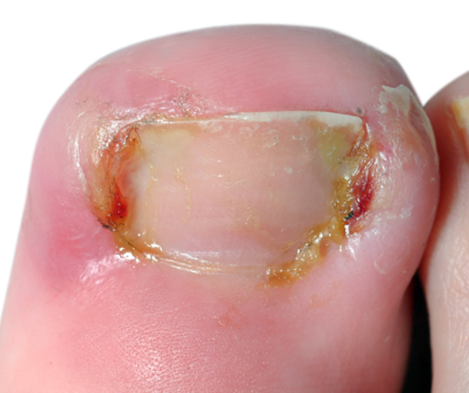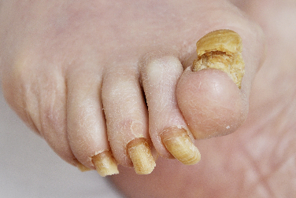
Involution – Pain and tenderness to the sides of the toe nail as well as the tip of the toe. Nail curvature is exaggerated and can look C shaped when viewing from the apex. This can often be confused with an ingrowing nail. Can often be managed with good personal foot care.

Onychocryptosis (Ingrowing Nail) An ingrowing toenail is where a piece of nail pierces the flesh of the toe. It can be extremely painful and inflamed or infected.
Ingrowing toenails most commonly affect the big toenail, but can affect the other toes too. A nail that is curling (involuted) into the flesh, but is not actually piercing the skin, is not an ingrowing toenail but can be very painful and can also appear red and inflamed.
image courtesy of NHS Lothian

Thickened and overgrown nails – Often characterised with thickening of the nail plate as well as discolouration. This is caused by a prolonged period where no personal foot care has been attempted. Often these are successfully self managed once the length and thickness has been addressed on a one off basis. Can often be prevented by good personal foot care.
Paronychia and Retronychia – Paronychia: Pain and tenderness to the toe at all sides of the toenail and on top of the toenail. Surrounding skin can be red and inflamed. In some cases this can become infected. Retronychia is linked with recurring paronychia. The nail will split close to the cuticle and ingrow into the nail fold. Usually a split is noted and/or redness at the cuticle and/or exudate.
Subungal Exostosis – A subungual exostosis is an isolated slow‐growing benign osteochondral outgrowth from the distal phalanx, which arises from under the nail. The big toenail is affected in three-quarters of cases. Less commonly, it affects other toes, or the fingers. A firm nodule develops from beneath the nail bed. The nodule usually grows slowly over weeks to months, and develops a thick hyperkeratotic surface. As it enlarges the nodule causes the nail plate to separate from the bed
Subungal Haematoma Deep red/black discoloration under the toe nail plate often following a trauma. In acute phase can be very tender to touch with inflammation of the surrounding skin seen. Once the acute phase has passed then often there is no pain. There is a clear demarcation line were new healthy nail grows. It can take up to 1yr for a new healthy nail to regrow. No management required.
Subungal Ulceration – This can be painful however often they are asymptomatic particularly in those with altered protective sensation. A break in the skin occurs under the nail plate. Often a soft, spongy layer is noted and discharge is evident. There may be some swelling of the surrounding skin particularly if the site is infected.
Fungal Nail Infections – see Dermatology page, Common Nail Disorders (nhslothian.scot)
all images are courtesy of NHS Lothian
M.A. & L.S. 15-05-24
Referral Criteria:
- Ingrowing nails (onychocryptosis)
- Symptomatic or infected curved or pincer type nails (involution)
- Paronychia/Retronychia
- Overgrown/rams horn nails (onychogryphosis)
- Suspected subungal ulceration or subungal exostosis
Patients with any of the above nail conditions who have Diabetes and/or PVD should be referred urgently to the Podiatry Community Service
Patients under the age of 12yrs can be assessed for nail surgery by our department but whether they are suitable will be decided on an individual basis and they may need to be referred onto RHSC for the procedure to be carried out.
Who not to refer:
- Basic personal foot care and nail cutting requests
- Asymptomatic nail pathology in healthy individual
- Fungal nail infections (patient information leaflet available in resources and links section and further information available on dermatology ref help page)
- Suspected subungual melanomas. These should be referred urgently to dermatology.
Ingrowing nails, paronychia and infected involuted nails
Provide patient information leaflet Ingrown nails, if symptoms do not resolve within 7-14 days or worsen, refer or advise patient to self refer.
If an ingrowing nail is infected, prescribe appropriate antibiotic and make an urgent referral.
NHS Lothian Podiatry Patient Information Leaflets
Ingrown Toenails (nhslothian.scot)
Personal Foot Care (nhslothian.scot)
Fungal Nail Infections (nhslothian.scot)
Personal Footcare Guidance
Personal Footcare – The Knowledge Network: Scotland’s source of knowledge for health and care













